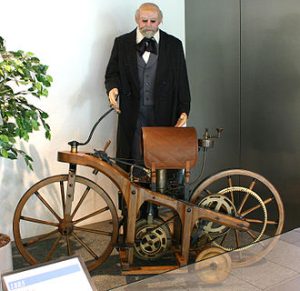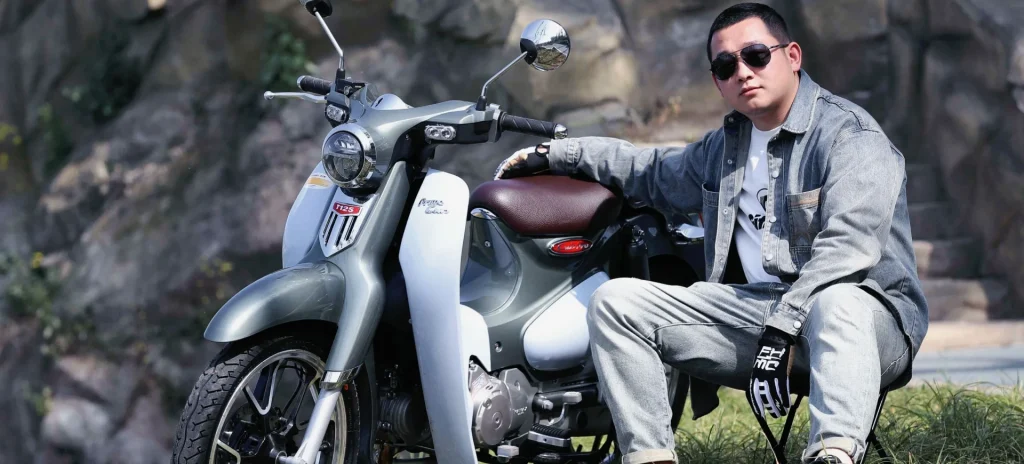The story of motorcycle design is one of ingenuity, daring, and relentless pursuit of speed and freedom. From humble beginnings as motorized bicycles to the high-tech marvels of today, motorcycles have evolved dramatically, reflecting broader technological advancements and cultural shifts. This narrative will take you through the critical eras of motorcycle design, exploring how each period brought about significant changes that shaped the motorcycles we ride today.
The Genesis: Birth of a New Machine (1885-1910)
Imagine the late 19th century, a time when the world was still getting accustomed to the idea of mechanized transport. Bicycles were the primary means of personal transportation, and inventors were obsessed with adding engines to them.In 1885, in a small workshop in Germany, Gottlieb Daimler and Wilhelm Maybach constructed a wooden-framed vehicle they called the “Reitwagen” or “riding car.” With its crude internal combustion engine, this contraption is widely regarded as the first true motorcycle.
The Reitwagen was more of an experimental vehicle than a practical mode of transport, but it sparked the imagination of inventors and engineers worldwide.
By the early 1900s, several companies were producing motorized bicycles. Among them were Indian and Harley-Davidson, two American firms that would go on to define the motorcycle industry.
The 1901 Indian Single featured a chain drive, which significantly improved over the direct belt drives of the time, offering better reliability and performance.

Roaring into the 20th Century: The Formative Years (1910-1930)
As the 20th century dawned, motorcycles began to take on a more defined shape. The focus shifted from simply adding engines to bicycles to designing frames specifically to accommodate engines. The First World War played a pivotal role in this evolution. Military demands pushed manufacturers to develop more robust and reliable machines, significantly influencing the design of motorcycles. The Harley-Davidson Model 11F, introduced in 1915, with its three-speed transmission, was a significant technological leap, a direct result of the war’s influence on motorcycle design.
Post-war, motorcycles started to gain popularity among civilians, not just as a means of transport but also as a symbol of freedom and adventure. European manufacturers like BMW and Triumph began to emerge, each bringing their unique innovations. The 1923 BMW R32, with its horizontally opposed twin-cylinder engine and shaft drive, set a new standard for motorcycle engineering. This period also saw the rise of the café racer culture in Britain, where riders sought to make their bikes faster and more stylish.
The Golden Age: Glamour and Speed (1930-1960)
The period between the 1930s and 1960s, often referred to as the “Golden Age” of motorcycling, saw significant technological advancements and the emergence of iconic motorcycles that would become legends. During World War II, motorcycles were essential for communication and surveillance. Models like the Harley-Davidson WLA and the BMW R75 became synonymous with military ruggedness and reliability, leaving a lasting impact on the motorcycle industry.
After the war, the motorcycle industry experienced a boom. Economic prosperity and a burgeoning youth culture fueled the demand for fast, stylish bikes. British manufacturers dominated the scene with models like the Triumph Bonneville, introduced in 1959. The Bonneville was celebrated for its performance and became a cultural icon associated with rock ‘n’ roll and rebellion.
The 1950s also saw the introduction of the scooter, a smaller, more practical alternative to the traditional motorcycle. The Italian company Vespa led the way with its stylish, easy-to-ride scooters, which became hugely popular in Europe and beyond. Scooters offered a new form of mobility, especially in urban environments, and appealed to a broader demographic, including women.
The Rise of the Japanese Giants: Precision and Reliability (1960-1980)
The 1960s marked the beginning of a new era in motorcycle design dominated by Japanese manufacturers. Companies like Honda, Yamaha, Suzuki, and Kawasaki brought a new level of precision engineering and reliability. The 1969 Honda CB750 is often credited with revolutionizing the industry. Dubbed the first “superbike,” the CB750 featured a four-cylinder engine, disc brakes, and an electric starter, setting new standards for performance and reliability.
Japanese manufacturers focused on producing motorcycles that were not only powerful but also affordable and reliable. This approach rapidly gained them a significant share of the global market. The 1970s saw the rise of the sportbike, with models like the Kawasaki Z1 and the Suzuki GS750. These bikes were designed for speed and agility, featuring advanced engineering and sleek, aerodynamic designs.
The motocross and off-road segments also saw significant developments during this period. Yamaha’s DT-1, introduced in 1968, was the first dual-sport motorcycle that could be ridden both on and off-road. This versatility made it incredibly popular and laid the foundation for the modern adventure bike segment, a testament to the diverse applications of motorcycle design.
The Digital Revolution: High-Tech Marvels (1980-Present)
Rapid technological advancements have characterized the late 20th and early 21st centuries, and motorcycles have not been left behind. The introduction of computer-aided design and manufacturing has allowed for more precise and innovative motorcycle designs. Electronic fuel injection, advanced suspension systems, and sophisticated braking systems have become standard features.
One of the most significant trends of this era has been the focus on safety and rider assistance systems. Anti-lock braking systems (ABS), traction control, and ride-by-wire throttle systems enhance performance and safety. Manufacturers like BMW have introduced advanced suspension systems like the Telelever and Duolever, which offer superior handling and stability.
Another key development is the rise of the adventure bike. Models like the BMW GS series and the Honda Africa Twin have become popular for their versatility and capability both on and off-road. These bikes, equipped with advanced electronics, such as multiple riding modes and GPS navigation, are paving the way for the future of long-distance riding, exciting enthusiasts about the potential of modern motorcycle design.
The Electric Revolution: Paving the Way for the Future
Electric motorcycles are emerging as a significant trend as the world moves towards more sustainable transportation options. Companies like Zero Motorcycles and Harley-Davidson, with its LiveWire model, are at the forefront of this revolution. Electric motorcycles promise reduced emissions, lower maintenance, and instant torque, appealing to a new generation of environmentally conscious riders.
Designing electric motorcycles presents unique challenges and opportunities. Optimizing battery placement and weight distribution requires innovative engineering solutions. However, the flexibility of electric powertrains allows for unconventional and futuristic designs. The Arc Vector, with its sleek, aerodynamic aesthetics and advanced technology, exemplifies the potential of electric motorcycle design.
Cultural Impact and the Road Ahead
Throughout their history, motorcycles have been machines and cultural icons. They have symbolized freedom, rebellion, and adventure, deeply embedding themselves in popular culture. From the café racers of 1960s Britain to the outlaw biker gangs of America, motorcycles have been a part of countless subcultures and movements.
Looking to the future, the evolution of motorcycle design will continue to be shaped by technological advancements and societal changes. As urbanization increases, there will be a greater demand for practical, efficient, and environmentally friendly transportation options. Electric motorcycles are likely to play a significant role in this shift, offering a sustainable alternative to traditional internal combustion engines.
There is a large demand for small, cheap motorcycles in the developing world, and many of the firms meeting that demand now also compete in mature markets, such as China’s motorcycle Kamax, which makes a version of Honda’s venerable super cub, that is Cub Pro 125.
Furthermore, advancements in artificial intelligence and connectivity could lead to the development of smart motorcycles. These bikes could communicate with other vehicles and infrastructure, enhancing safety and efficiency. Imagine a motorcycle that can predict and avoid accidents, optimize real-time routes, and provide a connected riding experience.
Conclusion
The evolution of motorcycle design is a fascinating journey that mirrors the past century’s broader technological and cultural shifts. From the rudimentary Reitwagen to the high-tech electric bikes of today, motorcycles have continually evolved to meet riders’ changing needs and desires. As we look to the future, it is clear that motorcycles will continue to be at the forefront of innovation, offering new and exciting possibilities for those who seek the thrill of the open road.
This story of motorcycle design is not just about the machines but also about the people who ride them and the freedom they represent. As long as there are roads to ride and horizons to chase, the motorcycle will remain a symbol of adventure and the indomitable human spirit.


